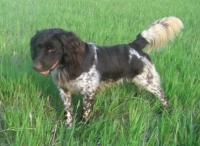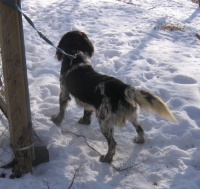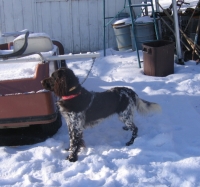Charly has a dense, long, slightly wavy coat with lots of feathering. His coat and form were rated as Very Good in German testing, which is considered to be outstanding. Charly weighs approximately 48 pounds and is 54cm in height, which is at the lower-end of the height scale for males. In addition to his very high test scores, Charly was selected for import into the Riverhill's breeding program because of his smaller size. The German judges who had recently critiqued SMCNA-registered Munsters recommended we make an effort to bring down the size of our Munsters, as over the years, the average size had crept upward toward the top of the scale.
Because Charly was trained and tested in Germany, deciphering his test scores can be difficult for those who are unfamiliar with the German testing system. And, it doesn't help matters that the test results and certificates are all in German.

The primary purpose of testing under the German system, much like the
VHDF and
NAVHDA systems in the USA, is to provide information for making breeding decisions and to evaluate the outcome of those decisions. The tests also provide a structure that helps to prepare a dog to be a competent and agreeable hunting companion. The tests are not a competition among dogs, but rather a measure of each dog against a standard.

The purpose of the Verbands-Jugend-Prüfung (VJP, or Natural Ability Test) and the Verbands-Herbstzucht-Prüfung (HZP, or Fall Breed Test) are to determine the natural abilities of young dogs with regard to hunting and future breeding potential. These tests are run during a dog's first year and a half. Nose, search, pointing, tracking, and cooperation are evaluated in the VJP, which is run in the Spring. Retrieving, water work, obedience and desire to work are added to these at the HZP in the subsequent Fall. Gun sensitivity/shyness is evaluated in both Tests.

The same 12-point scoring system is used for both the VJP and HZP Tests. Elevens and twelves can only be given in certain categories. A twelve may only be awarded in very special, difficult to accomplish situations. Even elevens require conditions which may not be present in every test situation. Therefore, a certain amount of luck often determines just how high a score a dog can get, regardless of how good he or she might be. Ten is the maximum score in obedience areas. For each testing category there is a multiplication factor, ranging from 1 to 3, depending on the relative importance of that quality. As a puppy buyer, it might be more important for you to look at the individual scores of the parents in the areas that are most important to you, rather than the total score. A dog must earn a minimum score of 6 in each category of the VJP in order to be approved for breeding by the SMCNA. The dogs are also examined for physical deficiencies and temperament faults at both Tests. A dog that shows any gun sensitivity or has any one of a number of physical defects, may not be used in a SMCNA breeding program.
The VJP attempts to measure a pup's inherited potential. The pup is scored on Tracking, Nose, Search, Pointing and Cooperation. A dog which receives an 8 in each VJP category, which would be considered a very good score, would receive a total score of 56 points. Charly scored a 71 at his VJP test.

The HZP is a measure of the young dog's actual usefulness as an upland and waterfowl hunting dog which has been trained to a moderately high degree. A dog which receives an 8 in each HZP category, which would be considered a very good score, would receive a total score of 144 points. Charly scored a 183 at his HZP test.
The Verbands-Gebrauchsprüfung (VGP, or Utility Test) evaluates the abilities of the fully trained dog and can be taken at any age. In addition to a more advanced level of the field and water work than was tested in the VJP and HZP, the VGP includes forest work with the retrieve of a dead fox and a blood track that simulates a wounded deer or other large game. A higher value is placed on Obedience in the VGP compared with the earlier breed tests and the dog is expected to be under complete control at all times. The VGP is a two-day test that takes place only in the Fall. In this test, the dog and handler are judged as a team. Scoring is on a 4-point system. The passing scores are designated with both point total and prize classification. To meet each prize classification, the dog and handler team must achieve a minimum point total and demonstrate qualifying performance in selected categories. Charly and his handler earned a Prize I with 331 points at his VGP test.

